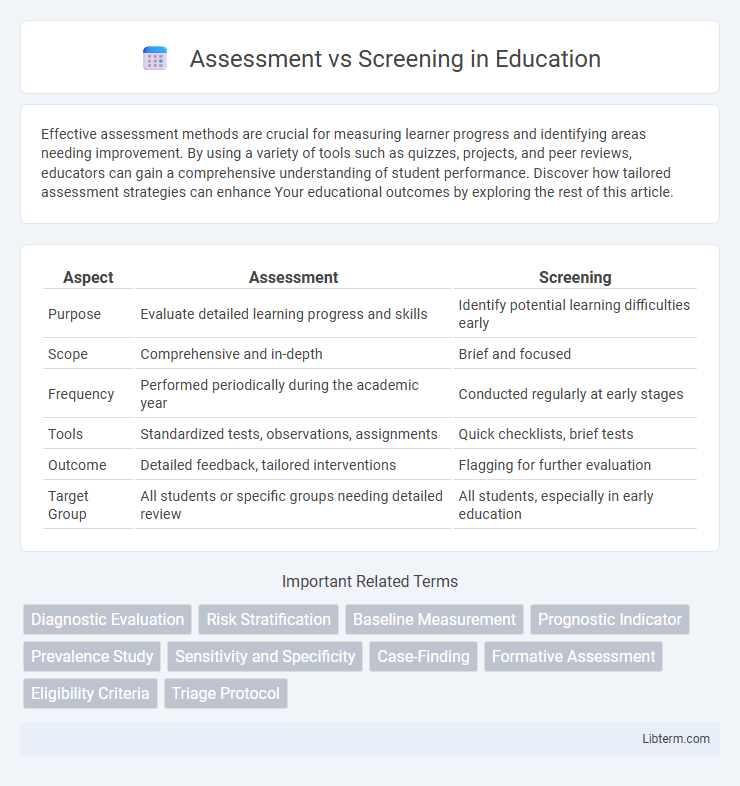Effective assessment methods are crucial for measuring learner progress and identifying areas needing improvement. By using a variety of tools such as quizzes, projects, and peer reviews, educators can gain a comprehensive understanding of student performance. Discover how tailored assessment strategies can enhance Your educational outcomes by exploring the rest of this article.
Table of Comparison
| Aspect | Assessment | Screening |
|---|---|---|
| Purpose | Evaluate detailed learning progress and skills | Identify potential learning difficulties early |
| Scope | Comprehensive and in-depth | Brief and focused |
| Frequency | Performed periodically during the academic year | Conducted regularly at early stages |
| Tools | Standardized tests, observations, assignments | Quick checklists, brief tests |
| Outcome | Detailed feedback, tailored interventions | Flagging for further evaluation |
| Target Group | All students or specific groups needing detailed review | All students, especially in early education |
Understanding Assessment and Screening
Assessment involves a comprehensive evaluation using various tools and methods to diagnose conditions or understand a person's abilities, skills, or needs in depth. Screening is a preliminary process that identifies individuals who may require further diagnostic assessment by quickly detecting potential issues or risk factors. Both are essential in healthcare and education for early intervention and tailored support.
Key Differences Between Assessment and Screening
Assessment involves a comprehensive evaluation process designed to identify strengths, weaknesses, and specific needs, often using multiple tools and methods over time. Screening is a brief, targeted procedure intended to detect potential issues early, usually through standardized tools that provide quick results. The key difference lies in depth and purpose: assessment offers detailed insights for diagnosis and intervention, while screening serves as an initial filter to determine who requires further evaluation.
Purposes of Assessment in Various Fields
Assessment serves to systematically collect detailed information to evaluate an individual's abilities, skills, and needs in fields such as education, psychology, and healthcare. It aims to diagnose conditions, guide personalized interventions, and measure progress over time, ensuring targeted and effective outcomes. Unlike screening, assessment provides comprehensive data for in-depth analysis and long-term planning.
The Role of Screening in Early Detection
Screening plays a vital role in the early detection of health conditions by identifying potential risks in asymptomatic individuals, facilitating timely intervention. Unlike comprehensive assessments, screenings are brief, targeted procedures designed to flag abnormalities for further evaluation. Early detection through screening can significantly improve treatment outcomes and reduce the progression of diseases.
Types of Assessments and Screenings
Assessments include diagnostic, formative, summative, and performance-based types, each designed to evaluate detailed knowledge, skills, or progress in educational or clinical settings. Screenings, such as vision, hearing, developmental, and mental health screenings, serve as preliminary checks to identify individuals who may need further evaluation. Both assessment and screening methods employ standardized tools and criteria to ensure accuracy and reliability in detecting strengths, weaknesses, or potential disorders.
Methods and Tools Used in Assessment
Assessment in educational and clinical contexts employs comprehensive methods and tools such as standardized tests, observational checklists, structured interviews, and performance tasks to gather detailed information about an individual's abilities, skills, and development. These tools are designed for in-depth evaluation, allowing practitioners to identify strengths, weaknesses, and learning needs through qualitative and quantitative data. Unlike screening, which uses brief, wide-net methods to identify individuals needing further evaluation, assessment focuses on precise, targeted instruments to diagnose, plan interventions, and monitor progress over time.
Common Screening Techniques and Criteria
Screening techniques such as questionnaires, checklists, and brief interviews efficiently identify individuals at risk for specific conditions by utilizing criteria like symptom presence and severity thresholds. Common criteria for screening emphasize sensitivity and specificity to ensure early detection while minimizing false positives. These methods differ from assessment, which involves comprehensive evaluations to diagnose and plan treatment.
When to Choose Assessment Over Screening
Choose assessment over screening when detailed information is needed to diagnose a specific condition or to guide treatment planning. Assessments provide comprehensive data through standardized tests, clinical interviews, and observations, making them essential for complex cases or when initial screening flags potential concerns. Screening is typically brief and used for early identification, but assessments are critical when accuracy and in-depth understanding of an individual's condition are required.
Impact of Assessment and Screening on Outcomes
Assessment provides a comprehensive evaluation of an individual's skills, needs, and progress, enabling tailored intervention strategies that significantly improve personalized outcomes. Screening quickly identifies potential risks or issues, allowing for early detection and timely support, which reduces the likelihood of severe complications and enhances long-term success. Both processes play crucial roles in optimizing educational, health, and developmental outcomes by informing targeted actions and resource allocation.
Best Practices for Conducting Effective Assessments and Screenings
Effective assessments and screenings rely on standardized tools validated for specific populations, ensuring accuracy and reliability in identifying individual needs or risks. Best practices include clear protocols for administration, thorough training for professionals, and timely feedback to stakeholders to guide interventions. Integrating cultural competence and maintaining confidentiality enhances the relevance and ethical standards of the evaluation process.
Assessment Infographic

 libterm.com
libterm.com